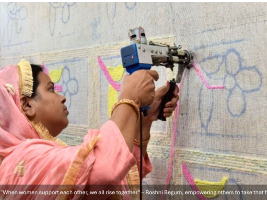Water and Gender Equity: Beyond Access to Agency

For women and girls in rural India, water scarcity is more than just an environmental challenge. It directly affects their dignity, health, and opportunities. According to the National Sample Survey, women in rural areas walk an average of 1.5 kilometres each day to fetch water, spending nearly 150 million workdays annually on this task alone. The cost of this cannot be measured in any statistics, but hours spent collecting water are hours lost from classrooms, fields, and enterprises. Every hour lost to fetching water is an hour not spent in school, at work, or in decision-making spaces. That is why it is critical to understand that access to water is inseparable from equity, and equity is inherently connected to gender.
Our work at Development Alternatives under the Resource Access and Equity programme has aimed to make this link visible and actionable by placing women at the centre of water systems. The programme, operating through various projects across the country such as Integrated Waste and Water Management with Hindustan Unilever in Nalagarh, Himachal, with LIC-HFL in Sonebhadra, DB Schenker India Pvt Ltd in Jhajjar, Haryana, the WASH partnership with UNICEF, and the Water Resilient Bundelkhand initiative supported by our partners, have encouraged and supported women-led committees in Bundelkhand to manage ponds and lead the waterbody management in a water-scarce area.
Under WASH initiatives, young girls across different villages in Bundelkhand, one of India’s most water-scarce regions, are given access to clean toilets and handwashing stations to help reduce dropout rates. Meanwhile, women-led committees not only manage village ponds and operate treatment plants to ensure safe water but also challenge deep-rooted beliefs about who holds technical expertise within the community. These changes are not cosmetic; they represent a shift from women being mere beneficiaries to becoming custodians, bridging policy, practice, and participation, and thus fostering systemic change.
Translating policy into equity requires a grounded understanding of the lived realities. That is where practice comes into play. It is ground zero where changes occur. By shifting from access to agency and aligning programme design with local needs, we monitor and evaluate progress through real time actions like reducing women’s drudgery, encouraging girls to stay longer in school, and enabling women to assert their place in local water institutions. This ensures that access becomes not just physical but genuinely equitable.
Another major cornerstone is participation. Without the voices of women in governance structures, water systems remain incomplete. When women lead water user groups, operate treatment plants, or serve in Talab Samitis, they do more than just manage resources; they redefine their active participation in the decision-making process. Their involvement ensures that decisions reflect the priorities of those most affected, and their leadership transforms water from a burden into a collective asset.
This nexus of policy, practice, and participation is what transforms access into agency. Safe water in schools does not merely improve infrastructure; it enables girls to continue their education. Reliable sanitation does not only prevent disease; it affirms dignity. Women-led governance does not only manage systems; it builds long-term resilience and equity across the community.
As we look ahead, the challenge is to deepen this approach: to continue embedding gender equity into water systems, to ensure policies are responsive to community voices, and to recognise participation as the key to sustainability. The theme of this month’s newsletter – Women, Water, and the Pursuit of Equity – builds on this approach and serves as a strong reminder that resilience cannot be built without justice and equity. It is not merely a footnote in development but its core. Safe water and sanitation are not only measured in taps and toilets but also in the freedom of women and girls to learn, to earn, and to lead.
Water, when governed equitably, does more than quench thirst. It shapes futures.
This blog first appeared as an editorial in Development Alternatives Newsletter November 2025 Women, Water, and the Pursuit of Equity






Leave a Reply